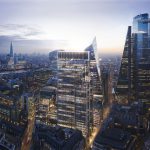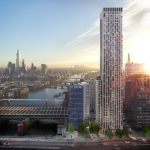Alex Beale, CPA NextGen Vice Chair and Foresight Manager at Landsec, chaired a recent CPA NextGen webinar exploring how design and placemaking can encourage mental and physical wellbeing in the City of London. Read his blog below:
This year, the City of London Corporation has renewed its Joint Health and Wellbeing Strategy, ensuring that everything that the Corporation does benefits the wellbeing of the community. For Marianne Fredricks, Chair of Health and Wellbeing Board at City of London Corporation, the pandemic has really highlighted the importance of mental and physical health. The first priority in the Strategy is good mental health for all and the prevention of suicide, and steps such as the opening of the City Wellbeing Centre in Aldgate last year show the progress being made.
Social isolation, high pressure working situations and long hours are triggers to mental health deterioration and can be especially acute for the working population of the City. In addition, periods of severe economic problems and job instability are only adding to the adverse effects on mental health of the community.
The pandemic has allowed the City to fast-track programmes already in-flight and start new ones. An example being the moves to transform its road network, with more cycle lanes, closing roads to traffic and widening of pedestrian routes, as well as building consolidation centres to reduce delivery servicing. These measures will mean once people return, they will notice how the City is more of a place for people than ever.
All stakeholders have a role to play to create the best environment for everyone who visits, works and lives in the City. A partnership approach is needed between authorities, developers, designers and experts, especially in the City where there is a real need for healthcare facilities, outdoor amenity spaces and public realm that connects people to nature.
Health is an ongoing process rather than a binary event, and for Araceli Camargo, Neuroscientist and Director at The Centric Lab, the fundamental rule is that sick places make sick people.
We must stop thinking about single factors making up wellbeing, when in fact health is a multifactorial holistic ongoing process. The ideal is for people to have constant access to resources that allow the body reach homeostasis, or a return to wellness, but unfortunately our highly artificial cities mean we have a lot of work to do.
Urban habitats should be in symbiosis with nature; protecting, nourishing and forming a reciprocal relationship between people and planet. Both internal and external environments should harness the way nature takes care of us, for example plants are great humidifiers and creators of oxygen.
Places that are not designed with climate change in mind are having adverse effects on their experience and perception. Wind tunnels created by tall buildings ultimately mean people choose not to use those places if they can’t find respite from harsh conditions. Our cities should take design tips from woodland, where you can readily find shelter from wind, rain and heat. Too often our urban realm is the antithesis of this, which is especially unfair to the neurodivergent and elderly.
As well as being the second biggest market of WELL accredited projects in the world, the UK is leading the way for net zero carbon projects too, but Richard Francis, Sustainability Director at Gardiner and Theobald, says we need to find ways to join the dots. The alphabet soup of certification and concerns has been simplified to these two and the real trick is to make sure they work together rather than against. While places must not contribute carbon, but they also must be pleasant to be in and the key word to achieving that is natural – natural air, natural light and natural materials.
You can’t build a premium office building in any city in the world without accreditation anymore, whether that’s through WELL, RESET or others, the ability to monitor their effects is only going to accelerate. We’ve had 9 months which has really highlighted the impact of indoor environments on our work and life and people are going to demand this is communicated to them so they can make informed choices as to where they spend their time.
Joe Haire of Red White Architects believes that it is critical that the office must do everything people miss while working from home. Contributing to that is the link between bringing people together and boosting their self-esteem. Working on a student housing project in Southampton it became clear that the priority to achieving this was to get residents out of their rooms and bring them together, to work and socialise, and this is an aspect that the office must mirror.
In a recent office scheme in Covent Garden a bold, characterful design reflects the local area and creates a reception space that energises workers as they arrive into an activated hub, ultimately making for a much happier place for people to go to. Their own new office displays their activity and purpose to those passing by because its in an old shopfront, bringing the social activity spaces to the front, so that everyone arriving or even passing by has a social interaction immediately.
I wonder how many more organisations in the future will think of their workspaces as a shopfront for what they do. Companies are poised to change how they operate in an increasingly hybrid world according to Iva Kleinova, the Research Team Leader at HB Reavis, but companies working across industries will need the office to be creative and build trust with their workforce and customers, as research shows that works best in person. The design of Bloom in Farringdon is centred around nature, with huge terraces, masses of greenery and certifications in both health and sustainability.
A more widespread hybrid working model is allowing people to question where they live and why it needs to be so close to where they work if they aren’t travelling as often. Places close to transport nodes are more attractive to 2-day-a-week commuters. Furthermore, the City offers a great example of a place where you can access lots of life’s needs within 15 minutes on foot or by bike.
The Pandemic has meant that the connection between where we are and how we are is being fundamentally revaluated, meaning it is more important than ever that the built environment enhances people’s quality of life.


